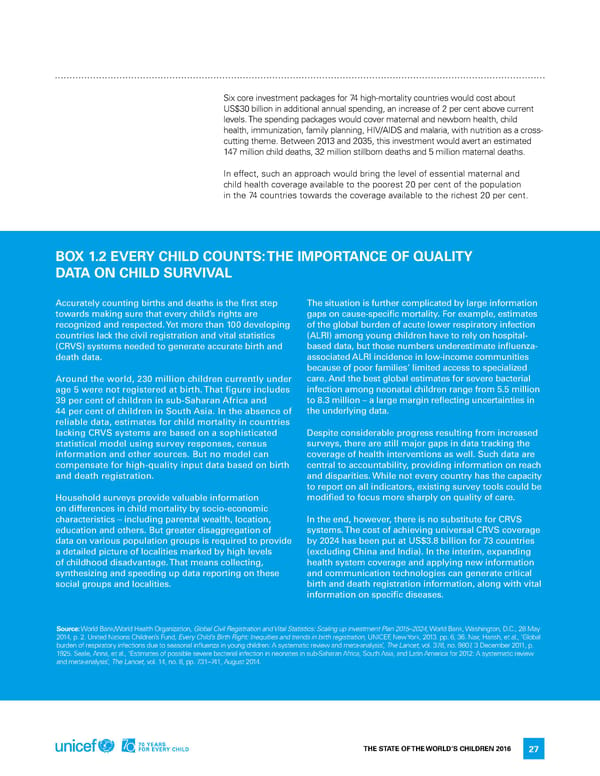Six core investment packages for 74 high-mortality countries would cost about US$30 billion in additional annual spending, an increase of 2 per cent above current levels. The spending packages would cover maternal and newborn health, child health, immunization, family planning, hiV/aidS and malaria, with nutrition as a cross- cutting theme. Between 2013 and 2035, this investment would avert an estimated 147 million child deaths, 32 million stillborn deaths and 5 million maternal deaths. in effect, such an approach would bring the level of essential maternal and child health coverage available to the poorest 20 per cent of the population in the 74 countries towards the coverage available to the richest 20 per cent. BOx 1.2 EvERY CHILD COUNTS: THE IMPORTANCE OF qUALITY DATA ON CHILD SURvIvAL Accurately counting births and deaths is the first step The situation is further complicated by large information towards making sure that every child’s rights are gaps on cause-specific mortality. For example, estimates recognized and respected. yet more than 100 developing of the global burden of acute lower respiratory infection countries lack the civil registration and vital statistics (ALRI) among young children have to rely on hospital- (CRVS) systems needed to generate accurate birth and based data, but those numbers underestimate influenza- death data. associated ALRI incidence in low-income communities because of poor families’ limited access to specialized Around the world, 230 million children currently under care. And the best global estimates for severe bacterial age 5 were not registered at birth. That figure includes infection among neonatal children range from 5.5 million 39 per cent of children in sub-Saharan Africa and to 8.3 million – a large margin reflecting uncertainties in 44 per cent of children in South Asia. In the absence of the underlying data. reliable data, estimates for child mortality in countries lacking CRVS systems are based on a sophisticated Despite considerable progress resulting from increased statistical model using survey responses, census surveys, there are still major gaps in data tracking the information and other sources. But no model can coverage of health interventions as well. Such data are compensate for high-quality input data based on birth central to accountability, providing information on reach and death registration. and disparities. While not every country has the capacity to report on all indicators, existing survey tools could be Household surveys provide valuable information modified to focus more sharply on quality of care. on differences in child mortality by socio-economic characteristics – including parental wealth, location, In the end, however, there is no substitute for CRVS education and others. But greater disaggregation of systems. The cost of achieving universal CRVS coverage data on various population groups is required to provide by 2024 has been put at US$3.8 billion for 73 countries a detailed picture of localities marked by high levels (excluding China and India). In the interim, expanding of childhood disadvantage. That means collecting, health system coverage and applying new information synthesizing and speeding up data reporting on these and communication technologies can generate critical social groups and localities. birth and death registration information, along with vital information on specific diseases. Source: World Bank/World health organization, Global Civil Registration and Vital Statistics: Scaling up investment Plan 2015–2024, World Bank, Washington, d.C., 28 May 2014, p. 2. United nations Children’s fund, Every Child’s Birth Right: Inequities and trends in birth registration, UniCef, new York, 2013. pp. 6, 36. nair, harish, et al., ‘Global burden of respiratory infections due to seasonal influenza in young children: a systematic review and meta-analysis’, The Lancet, vol. 378, no. 9807, 3 december 2011, p. 1925. Seale, anna, et al., ‘estimates of possible severe bacterial infection in neonates in sub-Saharan africa, South asia, and latin america for 2012: a systematic review and meta-analysis’, The Lancet, vol. 14, no. 8, pp. 731–741, august 2014. The STaTe of The World’S Children 2016 27
 70 Years for Every Child Page 41 Page 43
70 Years for Every Child Page 41 Page 43